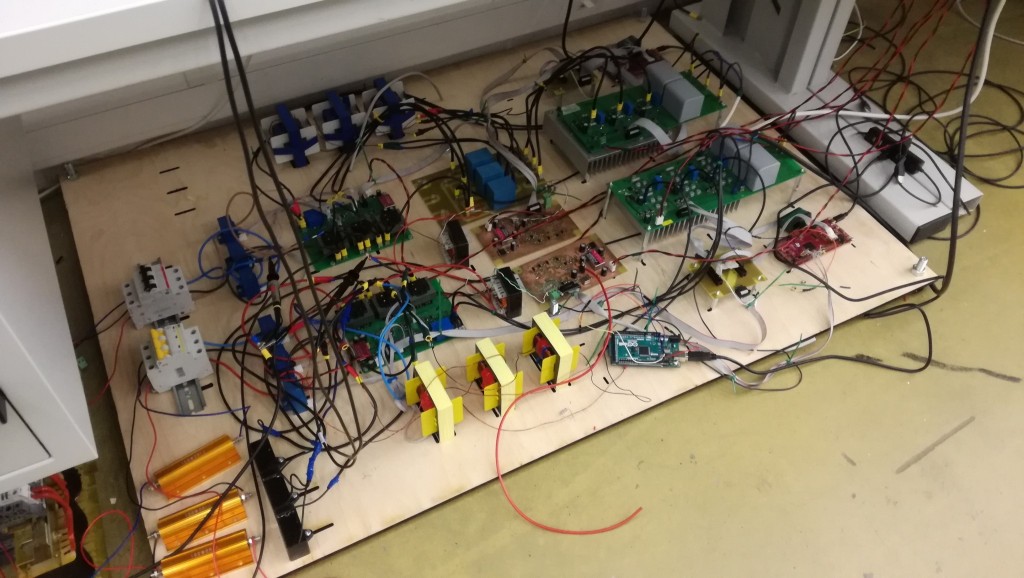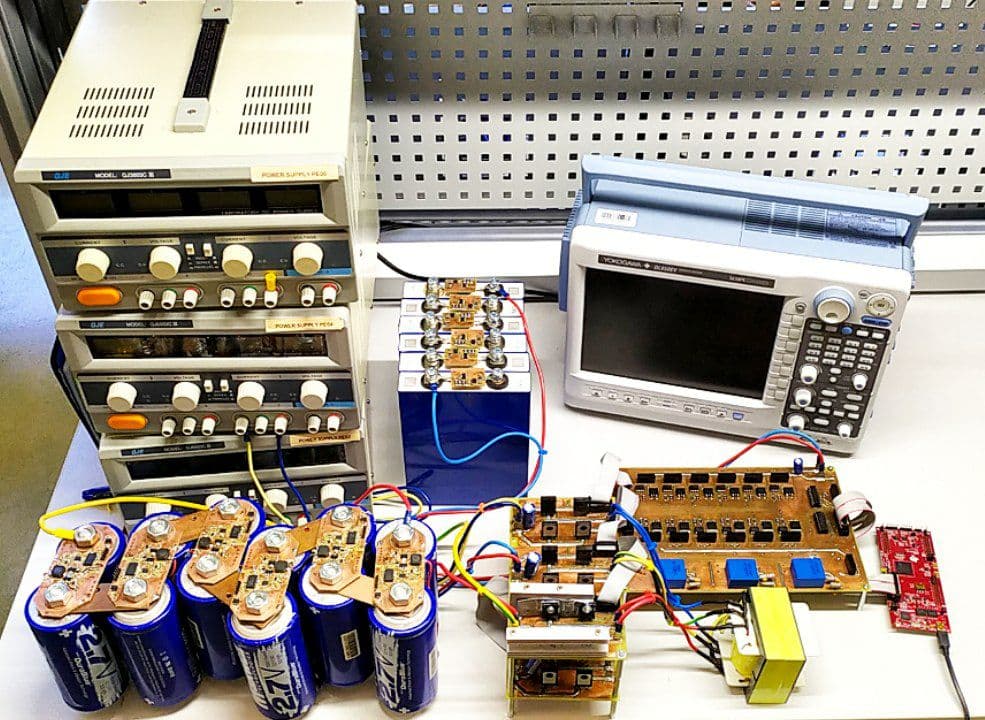Master theses
Regarding research activities, several master students have taken advantage of the lab facilities by validating their studies in power electronics laboratory:
- “Power Sharing Between Inverters in Standalone Microgrids”, master thesis 2021, MSc Mahmoud AlSadat, supervisor Prof. Ibanez
Abstract:
Renewable energy integration currently faces a lot of challenges. One of the proposed solutions is the concept of microgrid (MG). MG consists of a cluster of distributed generators (DGs) connected to the main utility grid and they have two modes of operation; grid connected and stand alone modes. To ensure stable operation of a MG, active and reactive powers should be shared properly. This is done conventionally with the help of droop control. However, droop control has some limitations specifically in reactive power sharing. In this work, a method for properly sharing reactive power is proposed utilizing low bandwidth communication through power lines. Using these communication signals, virtual impedances of the inverters are adjusted to achieve better reactive power sharing. The viability of the proposed method is verified by simulation in MATLAB/Simulink. Results show that the proposed algorithm is able to accurately achieve reactive power sharing while maintaining the power quality at the load bus. In addition, the implementation of the proposed method on inverter hardware is currently being done and the initial experimental results for active power sharing are presented.
- “Multi-Port Isolated DC/DC Converter for Multilevel Inverters application Master’s Educational Program: Energy science and technology”, master thesis 2021, MSc Peyman Koohi, supervisor Prof. Ibanez
Abstract:
Nowadays, multi-port DC/DC converters (MPCs) are taking part in modern electrical systems, where several DC/DC converters are required. One of these applications is the multi-level inverter, which needs several DC inputs. The multi-active bridge (MAB) converters are suitable for this application due to their high-power density and high efficiency; besides, galvanic isolation and bidirectional power flow capability are crucial, and MAB converters can provide all these requirements. MAB converters have a significant problem which is the cross-coupling effect. In this work, two different approaches are proposed to solve this problem. The first approach is the first order harmonic approximation and solves the power flow as an AC system, and the second approach is the inherent decoupled power flow which is done at the hardware level. The inherent decoupled power flow has much simpler control. However, it has lower efficiency and doesn’t have bidirectional power flow capability in all ports. To overcome the low efficiency problem, another modulation technique is implemented. And to have bidirectional power flow, the variable inductor is used instead of the conventional inductors. In addition, a new GMDH-based neural network model is investigated for variable inductor and validated by experimental tests.
- “Modelling and Control of Bidirectional Vienna Rectifier for Electric Vehicle Charging Applications” master thesis, MSc Fater Akhuwa 2021, supervisor Prof. Ibanez.
Mr. Fater Akhuwa has been modelling the Vienna rectifier and he implemented a control for bidirectional applications.
Abstract:
The electrification of transportation, if achieved, promises to be a primordial step towards achieving the net-zero emissions target set in the Paris Climate Agreement. With electrification of transportation comes unique challenges, one of which is the replacement of gas stations’ infrastructure with electric charging stations since vehicles will need electricity, rather than gas to be powered. Just as traditional internal combustion engine (ICE) automobiles spawned the need for more gas stations, EVs will also drive the demand for more public charging options. To achieve this, there is a need to design and develop charging systems that are cheap, robust and efficient. One famous rectifier topology used for electric vehicle charging purposes is the Vienna rectifier. The Vienna rectifier is popular due to its three-level switching implementation, higher efficiency, reduced voltage stresses on components, and higher power density. The Vienna rectifier is a three-phase, three-switch, three- level unidirectional boost-type AC/DC converter (or rectifier). There exists an abundance of literature about the Vienna rectifier and its application in the charging of electric vehicles. The contribution of this thesis will be to dig deeper into the design and control of the Vienna rectifier with an added function of reactive power compensation to help stabilize the electric grid. A small-signal model for the Vienna rectifier is developed and a MATLAB/Simulink simulation is made. Simulation results show that with this topology, reactive power compensation is possible for up to +/- 20% of the grid current. Experimental verification of simulation results is also carried out.
- “Stability of DC microgrids with DCDC buck converter” master thesis 2020, MSc Iosua Eletu, supervisor Prof. Ibanez
| Mr. Eletu developed an algorithm to modify the pulse-modulation signal which controls the Buck DCDC converter in order to avoid oscillations in the input DC port. Details of the mechanism can be found in Master thesis or in the following article.F. M. Ibanez, F. Martin, J. Eletu and J. M. Echeverria, “Input voltage feedforward control technique for DC/DC converters to avoid instability in DC grids,” in IEEE Journal of Emerging and Selected Topics in Power Electronics, doi: 10.1109/JESTPE.2021.3058850. | 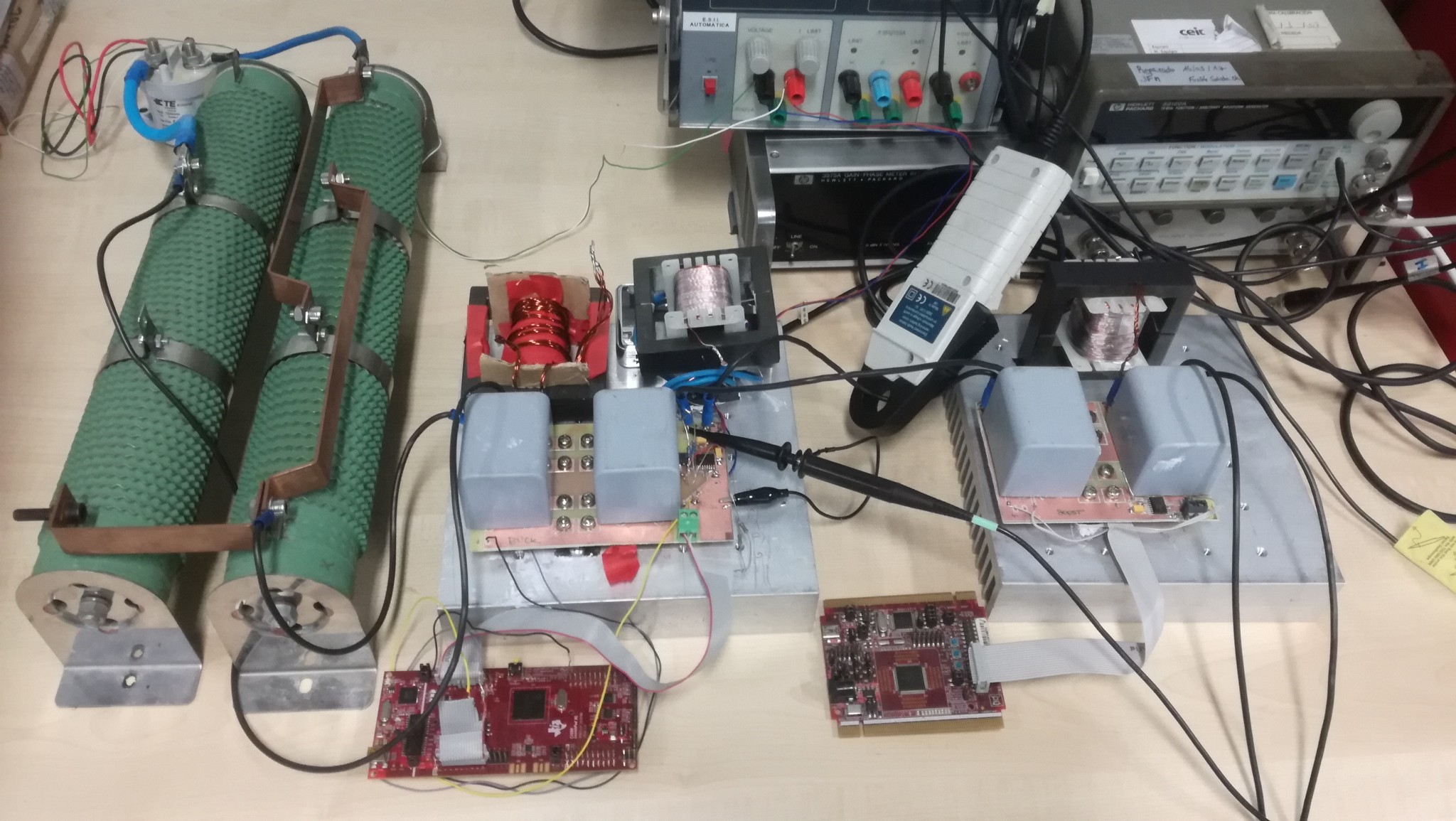 |
Abstract:
- “Optimal design methodology for high-power interleaved bidirectional DC-DC converters in electric and hybrid aircrafts”, master thesis 2020, MSc Arnur Karbosov, supervisor Prof. Ibanez
| Mr. Karbosov has been studying and optimizing different DC/DC converter topologies for “More electric airplanes” (MOA). He put emphasis in two types of converters, the traditional half-bridge converter which can work as a buck or as a boost converter and an isolated DC/DC converter, the dual active bridge (DAB). His studies included the analysis of power density, cost and reliability as the number of parallel entities increase when the power increases. Outcomes of his studies are his master thesis and a conference paper in which he explains the methodology that he used for the converters’ design. Mr. Karbosov gave an oral presentation in ICRERA’2019 in Brasov, Romania.A. Karbozov and F. M. Ibanez, “Optimal Design Methodology for High-Power Interleaved Bidirectional Buck-Boost Converters for Supercapacitors in Vehicular Applications,” 2019 8th International Conference on Renewable Energy Research and Applications (ICRERA), 2019, pp. 152-157, doi: 10.1109/ICRERA47325.2019.8996530. | 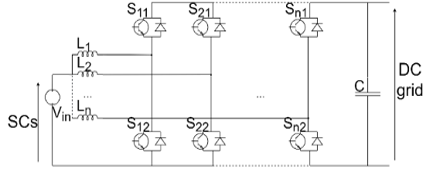 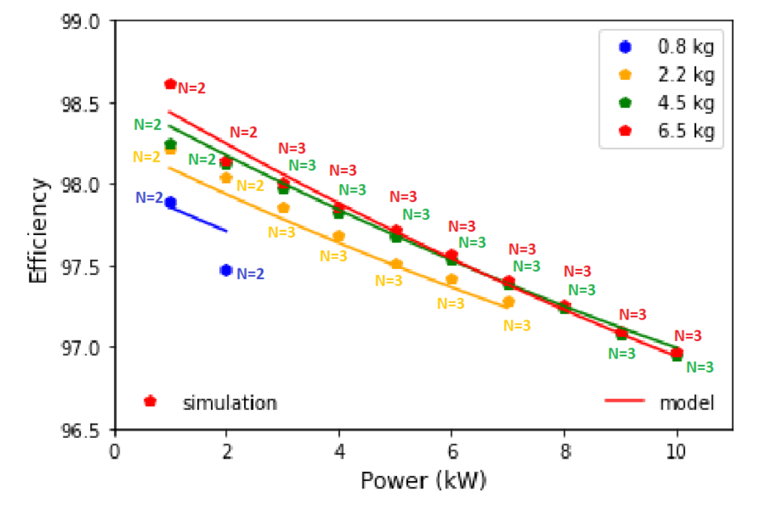 |
Abstract:
- “Aging and Modeling of Lithium-Ion Battery for Electric Vehicle Applications '” master thesis 2020, MSc Tanvir Ahmed, supervisor Prof. Ibanez
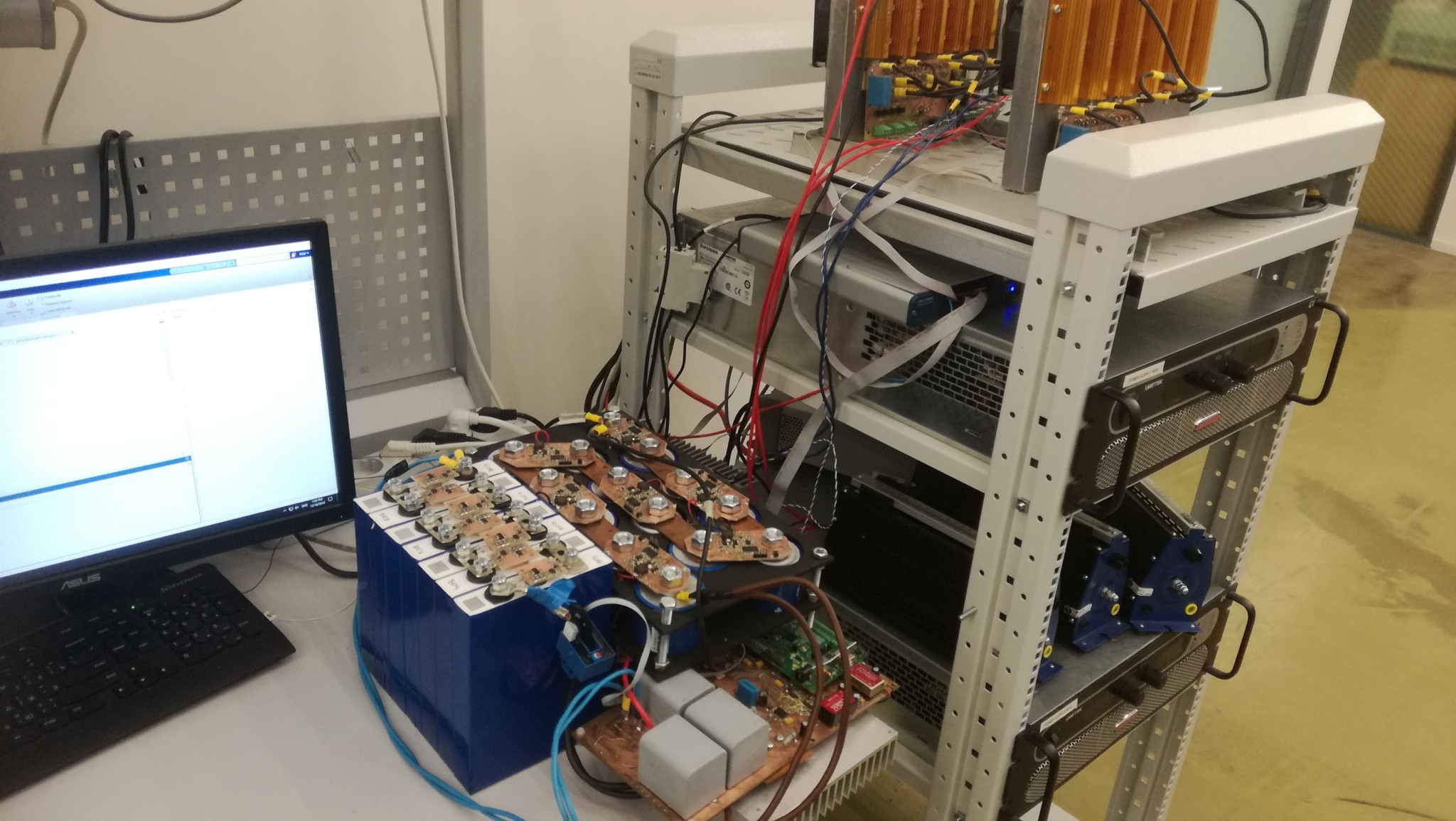 |
Mr. Tanvir Ahmed has been studied the impact of the hybrid storage system in battery lifetime using and advanced algorithm which emulated a low-pass filter in order to smooth the current in the battery. Thus, the high power pulses are delivered with other source, the supercapacitor. The picture shows the main blocks of the system, the supercapacitores, the batteries and the converters which controls the power flow. Finally, the power sources and loads emulates a real power profile of an electric motorcycle with regeneration.More information can be found in the published conference paper:F. M. Ibanez, T. Ahmed, I. Idrisov and J. S. Gutierrez, “An Impedance Based Modeling Towards the Aging Prediction of Lithium-Ion Battery for EV Applications,” 2019 8th International Conference on Renewable Energy Research and Applications (ICRERA), 2019, pp. 146-151, doi: 10.1109/ICRERA47325.2019.8996568. |
Abstract:
- “Demand Response Based on Droop Control for the Grid Frequency Control”, master thesis, 2019 MSc Maksim Parshin, supervisor Prof. F. Ibanez, co-supervisor, Prof. D. Pozo.
Mr. Maksim Parshin has been researching on the control of thermostatic loads and the impact of that in a micro grid. He developed a control algorithm and validated his studies in the micro grid lab. The results of his research is detailed in his master thesis and in the following conference paper:M. Parshin, M. Majidi, F. Ibanez and D. Pozo, “On the Use of Thermostatically Controlled Loads for Frequency Control,” 2019 IEEE Milan PowerTech, 2019, pp. 1-6, doi: 10.1109/PTC.2019.8810985. |
 |
Abstract:
